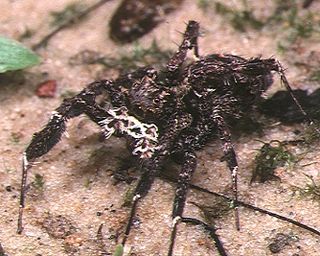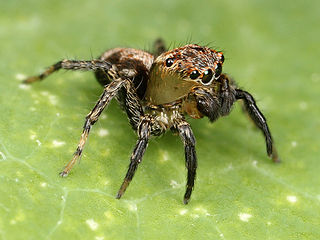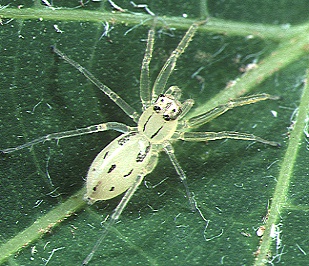Nebridia is a monotypic genus of Venezuelan jumping spiders containing the single species, Nebridia semicana. It was first described by Eugène Louis Simon in 1902, and is only found in Venezuela. It was briefly considered a synonym of Amphidraus, it was elevated to genus status in 2017.

Omoedus is a genus of jumping spiders.
Thianitara is a genus of Southeast Asian jumping spiders that was first described by Eugène Louis Simon in 1903. As of August 2019 it contains only two species, found in Thailand, Indonesia, and Malaysia: T. spectrum and T. thailandica. It was briefly considered a junior synonym of Thiania until 2017, when it was revived by Jerzy Prószyński.
Tomocyrba is a genus of Malagasy jumping spiders that was first described by Eugène Louis Simon in 1900.

The Spartaeinae are a subfamily of the spider family Salticidae. The subfamily was established by Fred R. Wanless in 1984 to include the groups Boetheae, Cocaleae, Lineae, Codeteae and Cyrbeae, which in turn were defined by Eugène Simon.

Salticinae is a subfamily of jumping spiders. It includes over 90% of the known species of jumping spiders. The subfamily is divided into two unranked clades: Amycoida and Salticoida.

Lyssomaninae is a subfamily of jumping spiders. It includes four genera, three from the New World.

Mexcala meridiana is a species of jumping spider in the genus Mexcala that is endemic to South Africa, found in Mpumalanga. The spider was first defined in 2009 by Wanda Wesołowska, one of over 500 that the arachnologist described during her career. It mimics ants and ant-like wasps, living alongside and preying upon them. Only the female has been identified. The spider is medium-sized, with a brown to blackish carapace typically 3.0 mm (0.12 in) long and a brownish abdomen typically 4.0 mm (0.16 in) long. It is similar externally to other spiders in the genus, the most distinguishing feature being its copulatory organs.

Mexcala namibica is a species of jumping spider in the genus Mexcala that is endemic to Namibia, after which it is named. The spider was first defined in 2009 by Wanda Wesołowska, one of over 500 that the arachnologist described during her career. It mimics ants, living alongside and preying upon them, particularly Camponotus detritus. Only the male has been described. It is a medium-sized spider, with ablackish carapace typically 3.3 mm (0.13 in) long and a reddish-orange abdomen typically 4.1 mm (0.16 in) long. It is similar to others in the genus, but can be distinguished by the dark pattern on its abdomen, consisting of a stripe to the front, two patches in the middle and black chevrons at the back.
Thiratoscirtus bipaniculus is a species of jumping spider in the genus Thiratoscirtus that lives in Nigeria. The species was first described in 2011 by Wanda Wesołowska and Russell-Smith. The holotype was found on Obudu Plateau, Cross River State at an altitude of 1,900 m (6,200 ft) above sea level. Only the female has been described. It is a medium-sized spider, with a wider cephalothorax that is typically 2.6 mm long and a thinner abdomen that is 2.5 mm in length, both oval in shape. The mouthparts include powerful chelicerae with teeth that have multiple points and a short fang. It can be distinguished from other spiders in the genus by its copulatory organs, particularly the long thin insemination ducts and the presence of slightly sclerotized structures in the middle of the epigyne and two tufts of hair on the edges. The last of those features are recalled in the name for the species.
Thiratoscirtus harpago is a species of jumping spider in the genus Thiratoscirtus that lives in Nigeria. The species was first described in 2011 by Wanda Wesołowska and Russell-Smith. Only the male has been identified. It is a medium-sized spider, with a cephalothorax that is typically 3.9 mm long and an abdomen that is 2.7 mm in length, both oval in shape. The carapace is generally dark brown and the abdomen dark greyish-fawn on top. The clypeus, or face, has a triangular marking of white hairs. The mouthparts include large chelicerae and a short fang. Its copulatory organs are unusual, including the a very small palpal bulb enclosed in a cymbium that is shaped like a half-moon and a hook at the end of the embolus, which is recalled in the species name, a Latin word that can be translated "harpoon".
Thiratoscirtus monstrum is a species of jumping spider in the genus Thiratoscirtus that lives in Nigeria. The species was first described in 2011 by Wanda Wesołowska and Russell-Smith. Only the female has been described. It is a medium-sized spider, with a wider cephalothorax that is typically between 3.4 and 3.6 mm long and an abdomen that is 2.6 and 3.5 mm in length, both oval in shape. It is generally dark brown and grey on top and yellow and orange underneath, apart from its legs, which are light yellow. It has particularly unusual copulatory organs that enable it to be distinguished from other spiders in the genus, particularly the design of its epigyne, which is recalled in the species name. The epigyne looks like a large triangle and has a triangular depression in its middle. It has a single copulatory opening and gonopore, one insemination duct and small tube-like spermathecae, or receptacles.
Thiratoscirtus obudu is a species of jumping spider in the genus Thiratoscirtus that lives in Nigeria. The species was first described in 2011 by Wanda Wesołowska and Russell-Smith. The holotype was found at an altitude of 1,900 m (6,200 ft) above sea level. on Obudu Plateau, Cross River State, after which it is named. Only the male has been described. It is a medium-sized spider, with a wider cephalothorax that is between 2.7 and 2.8 mm long and a thinner abdomen that is 2.2 and 2.4 mm in length, both oval in shape. The mouthparts include robust chelicerae and a short fang. It can be distinguished from other spiders in the genus by its copulatory organs. It has a small pedipalp with a rounded palpal bulb and a small spike on its palpal tibia called a tibial apophysis The apophysis is smaller than that found on other species.
Thiratoscirtus vilis is a species of jumping spider in the genus Thiratoscirtus that lives in Nigeria. The species was first described in 2011 by Wanda Wesołowska and Russell-Smith. The holotype was found at an altitude of 1,900 m (6,200 ft) above sea level. on Obudu Plateau, Cross River State. Only the female has been described. It is a medium-sized spider, with a cephalothorax that is typically 3.4 mm long and an abdomen that is 3.5 mm in length, both oval in shape. The mouthparts include robust chelicerae and a short fang. It can be distinguished from other spiders in the genus by its copulatory organs, particularly the heart-shaped depression in the middle of the epigyne.
Thiratoscirtus procerus is a species of jumping spider in the genus Thiratoscirtus that lives in Nigeria. The species was first described in 2012 by Wanda Wesołowska and Glavis Edwards. It is a medium-sized spider with a slender body, which is recalled in the name, that is more reminiscent of a spider in the genus Brancus. It has a cephalothorax that is between 3.2 and 3.3 mm long and a larger abdomen that is between 4.4 and 5.6 mm in length, both oval in shape. The top of the cephalothorax, or carapace, is yellowish-orange and the bottom, or sternum, is yellow. The top of the abdomen is yellowish was an orange pattern and the bottom is yellowish-white. The spider's legs are also yellow. They are long and thin and have very long brown spines. The female has copulatory organs that are typical for the genus. The male has not been described.

Asemoneinae is a subfamily of jumping spiders. It was created in 2015 by Wayne Maddison. Most species are found in Africa or Asia. The subfamily initially had five genera, but Hindumanes was later transferred to the subfamily Lyssomaninae.

Amycoida is an unranked clade of the jumping spider family Salticidae. It is the smaller and less widespread of the two subdivisions of the "typical" jumping spiders, occurring mainly in the New World, particularly the Amazon basin. Its sister clade is the Salticoida.
Detalik is a genus of jumping spiders, consisting of four described species. The genus was first circumscribed in 2021 by Wanda Wesołowska, along with descriptions of the type species Detalik anthonyi and three other species. Another species was described in 2022. The spiders were first found in Nigeria but have also been identified living in Ivory Coast. Overall, the members of the genus are very small spiders, between 3.5 and 5 mm long. They have distinctive mouthparts, consisting of a short fang visible on the chelicerae along with a two small teeth to the front and a large tooth to the back. The carapace is noticeable for its almost vertical sloping back and the front legs are characterised with very long spikes on the tibia and metatarsus. Although the copulatory organs are unique to each member species, there are some common features. The males have a spike towards the back of the palpal bulb called a retromarginal apophysis and the female copulatory organs are hidden in a depression in the epigyne.
Pochyta tendicula is a species of jumping spider in the genus Pochyta that lives in Gabon. A small spider, it was first described in 2021 by Wanda Wesołowska and Tamás Szűts. It has a light brown oval cephalothorax that is typically 2.4 mm long and has eyes that are surrounded by dark rings. It has an ovoid abdomen, typically 2.2 mm long, that is generally greyish-beige on top and grey underneath. Its front pair of legs are longer than the others and marked with long spines. The male has distinctive copulatory organs, with a long embolus that projects from a small palpal bulb, and a small curved spike in the palpal tibia called a retrolateral tibial apophysis. The female has not been described.
Pochyta minuta is a species of jumping spider in the genus Pochyta that lives in Nigeria. It was first described in 2021 by Wanda Wesołowska and Tamás Szűts. A small spider, it has a cephalothorax that is typically 2.3 mm long and an abdomen 2.66 mm long. The cephalothorax is generally yellow apart from its black rings around the spider's eyes and a grey v-shaped marking on the carapace, or hard top shell. The abdomen is greyish-brown on top with a herring-bone pattern to the rear. The spider has long legs long brown spines. The female has a small epigyne, which is recalled in the species name that means "tiny". Internally, the spider's copulatory organs are similar to the related Pochyta pulchra. The male has not been described.








